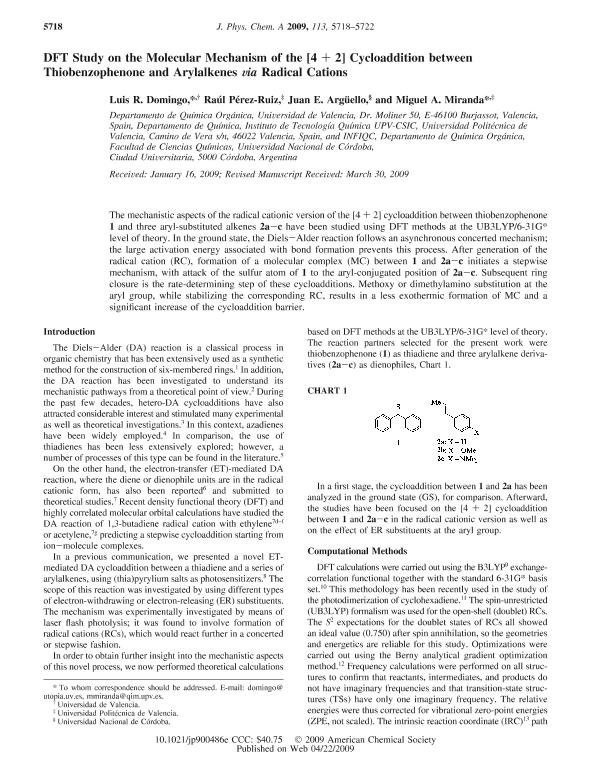Mostrar el registro sencillo del ítem
dc.contributor.author
Heredia, Luis Domingo

dc.contributor.author
Pérez-Ruiz, Raul
dc.contributor.author
Argüello, Juan Elias

dc.contributor.author
Miranda, Hernán Miguel

dc.date.available
2019-08-30T18:12:18Z
dc.date.issued
2009-05
dc.identifier.citation
Heredia, Luis Domingo; Pérez-Ruiz, Raul; Argüello, Juan Elias; Miranda, Hernán Miguel; DFT study on the molecular mechanism of the [4 + 2] cycloaddition between thiobenzophenone and arylalkenes via radical cations; American Chemical Society; Journal of Physical Chemistry A; 113; 19; 5-2009; 5718-5722
dc.identifier.issn
1089-5639
dc.identifier.uri
http://hdl.handle.net/11336/82615
dc.description.abstract
The mechanistic aspects of the radical cationic version of the [4 + 2] cycloaddition between thiobenzophenone 1 and three aryl-substituted alkenes 2a-c have been studied using DFT methods at the UB3LYP/6-31G level of theory. In the ground state, the Diels-Alder reaction follows an asynchronous concerted mechanism; the large activation energy associated with bond formation prevents this process. After generation of the radical cation (RC), formation of a molecular complex (MC) between 1 and 2a-c initiates a stepwise mechanism, with attack of the sulfur atom of 1 to the aryl-conjugated position of 2a-c. Subsequent ring closure is the rate-determining step of these cycloadditions. Methoxy or dimethylamino substitution at the aryl group, while stabilizing the corresponding RC, results in a less exothermic formation of MC and a significant increase of the cycloaddition barrier.
dc.format
application/pdf
dc.language.iso
eng
dc.publisher
American Chemical Society

dc.rights
info:eu-repo/semantics/openAccess
dc.rights.uri
https://creativecommons.org/licenses/by-nc-sa/2.5/ar/
dc.subject
Dft
dc.subject
Ion-Molecule Complex
dc.subject
Radical Cation
dc.subject
Reactivity
dc.subject.classification
Química Orgánica

dc.subject.classification
Ciencias Químicas

dc.subject.classification
CIENCIAS NATURALES Y EXACTAS

dc.title
DFT study on the molecular mechanism of the [4 + 2] cycloaddition between thiobenzophenone and arylalkenes via radical cations
dc.type
info:eu-repo/semantics/article
dc.type
info:ar-repo/semantics/artículo
dc.type
info:eu-repo/semantics/publishedVersion
dc.date.updated
2019-03-18T14:42:01Z
dc.identifier.eissn
1520-5215
dc.journal.volume
113
dc.journal.number
19
dc.journal.pagination
5718-5722
dc.journal.pais
Estados Unidos

dc.description.fil
Fil: Heredia, Luis Domingo. Universidad de Valencia; España
dc.description.fil
Fil: Pérez-Ruiz, Raul. Universidad Politécnica de Valencia; España
dc.description.fil
Fil: Argüello, Juan Elias. Consejo Nacional de Investigaciones Científicas y Técnicas. Centro Científico Tecnológico Conicet - Córdoba. Instituto de Investigaciones en Físico-química de Córdoba. Universidad Nacional de Córdoba. Facultad de Ciencias Químicas. Instituto de Investigaciones en Físico-química de Córdoba; Argentina
dc.description.fil
Fil: Miranda, Hernán Miguel. Universidad Politécnica de Valencia; España
dc.journal.title
Journal of Physical Chemistry A

dc.relation.alternativeid
info:eu-repo/semantics/altIdentifier/doi/http://dx.doi.org/10.1021/jp900486e
dc.relation.alternativeid
info:eu-repo/semantics/altIdentifier/url/https://pubs.acs.org/doi/10.1021/jp900486e
dc.relation.alternativeid
info:eu-repo/semantics/altIdentifier/url/https://www.ncbi.nlm.nih.gov/pubmed/19385638
Archivos asociados
